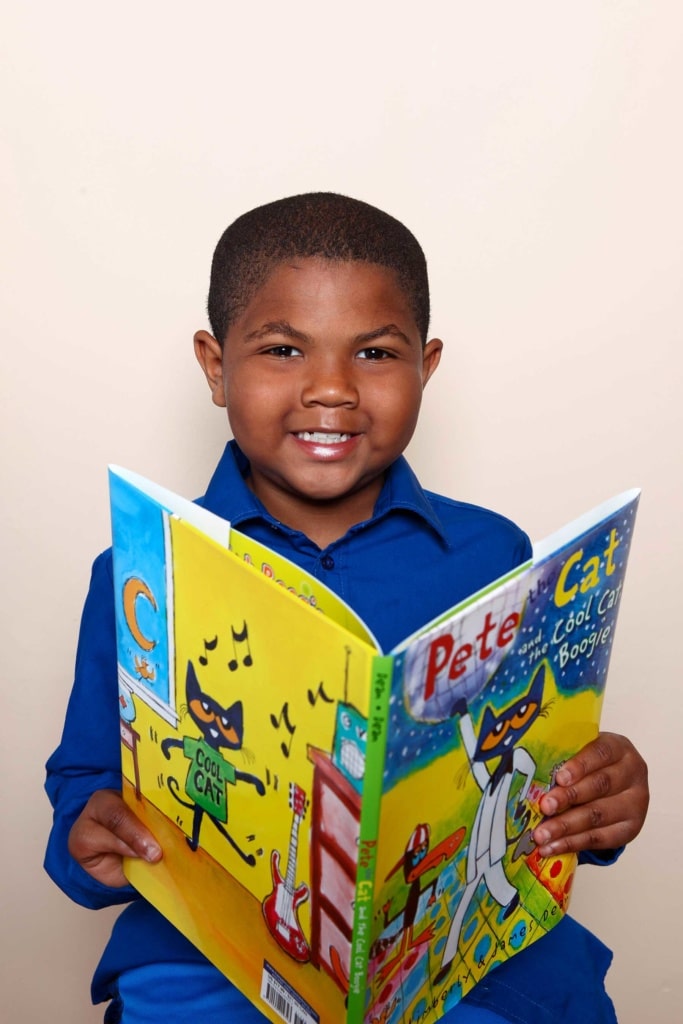When Christina Amodie begins teaching this fall, she will be spending an even larger chunk of the school day helping her students become better readers.
“When I first started teaching kindergarten, everything was focused on learning letters,” says Amodie, who is beginning her 20th year in the profession at Verona’s J.D. George Elementary School. “We had the Letter of the Week. We would teach the sounds for each letter. Now, we have them doing 50 sight words. We start sight words before they even have letter recognition or sound recognition.”
She confirms what many parents have long known: Kindergarten is no longer a leisurely transition from home nurturing to structured academics. And the push to get students reading and writing as early as possible has become more demanding. In addition to sight recognition and phonemic awareness—identifying the sounds that make up words—elementary school classrooms are now tasked with developing complex critical thinking and text evidence recognition skills.
But Amodie, of Camillus, and other local educators are finding creative ways to get students building the literacy skills they need.
“The reading piece is so key,” she says. “We’re trying to foster a love of reading. I have book nooks and little reading corners in my classroom, and I have all kinds of literature.”
In Amodie’s class, students are counting syllables and recognizing context clues during a lesson about the days of the week—bringing literacy practice and skill building into other subjects whenever possible. Students have activities based on their reading levels, but Amodie also has a “quiet time” read-aloud during which she chooses material that is just beyond their reading levels.
“That builds vocabulary, but also piques interest in something that they couldn’t read themselves,” she says. “They are listening to vocabulary that is a little bit higher than what they would be used to hearing in some of their grade-level stories.”

More Content, Earlier
Getting students to make progress in reading comprehension before they have mastered decoding is not easy. But the Common Core—more formally, the New York State Common Core Learning Standards Assessments—requires that students become adept in their understanding of complex text, starting in kindergarten and even earlier.
Building reading comprehension while also working on decoding (figuring out what words mean) early is the new normal, says Eric Larison, assistant superintendent for instruction for the Solvay Union Free School District.
For the past two years, Solvay has been implementing the Core Knowledge Language Arts program, which is recommended by the New York State Education Department for use in kindergarten through grade 2. (Solvay is using it through fourth grade.) CKLA is a curriculum that encourages teachers to bring complex vocabulary into their lessons, and to build on what students have already learned. The West Genesee, Lyncourt and Syracuse city schools are also currently using it.
“We are finding that children who may be able to decode a word, if they don’t have the background knowledge, they are not going to necessarily understand what that word means,” Larison says. “This causes problems down the road because reading comprehension is the ultimate goal of reading.”
Parents as Partners
Building literacy into a family’s evening routine is strongly encouraged in the West Genesee School District. Literacy coordinator Stephanie Finn encourages parents to keep reading to their children for as long as possible.
“There is such value in reading to your child. We stop that way too young,” she says. “Children eat it up when they are being read to. That’s where they get the vocabulary and that’s where they get the background knowledge. Even if it’s way above their reading level, if it’s a topic they are interested in, or something they know you’re interested in and you can share it, it’s a wonderful thing.”
With students more overscheduled than ever, some parents wrongly assume that it is OK to skip reading at home.
“Time for parents is so precious,” says Lori Keevil, K-2 principal at Stonehedge Elementary School in Camillus. “Getting parents to think of reading aloud to their children as a pleasurable experience, instead of a task that has to be done, is the paradigm where the shift needs to happen.”
Keevil points out that the listening component teachers use with CKLA can also be done at home. When children express an interest in a subject, parents can go to the library and get higher-level books to read to their child. When content and vocabulary is presented in context, children absorb more of it.
When students prefer to read on their own, there are still things parents can do to be active participants, says Solvay’s Larison. “They can talk to students about their independent reading books. That dialogue in itself becomes an encouragement for the child to read. It’s a very powerful thing that parents can do, and it’s very simple.”
Administrators in the West Genesee Central School, where CKLA was also implemented last year for grades K-5, will educate parents this fall on how the curriculum works and how they can support it.
Leveled readers and rote memorization are no longer part of early literacy instruction, Finn says. “One thing with the core knowledge program is that it does go slow to go fast. There is a purposeful sequence that they go through to teach children how to read so that by the end of the year you have true readers.”
When More is Not Enough
When students get beyond third grade, and are still struggling, parents need to take a more active role, says Keevil. “The classroom teacher and the reading specialist are there to support and to partner with parents in order to make sure that child succeeds.”
The need for academic intervention services (or AIS) is determined, primarily, by student performance on assessments, typically given three times a year. With the advent of Common Core, schools were required to offer reading intervention services to students who scored below a certain level on annual standardized tests. Many districts saw a jump in students who qualified for services based on those criteria.
Some districts are now employing creative ways of providing additional support. Some schools use learning centers or “reading buddies,” when an older student reads aloud to a younger student, to enhance reading.
At Seymour Academy in Syracuse last year, 140 first-grade students participated in a Book Buddies program staffed by local volunteers. They read with students twice a week for 30 minutes, and worked with struggling readers one on one.
Laurie Black, one of the coordinators of the program and director of the nonprofit Early Childhood Alliance Onondaga, says most of the participants were testing about a year behind grade level.
“They keep making progress, but they never actually catch up,” Black says. “I say you need a good three-legged stool to read: a great teacher, intervention for struggling readers, and reading practice. It really is a muscle that needs to be used in order to get stronger.”
Solvay is considering having literacy specialists push-in to support students rather than pulling students out of class, as has been the norm, says Amanda Simmons, who served as Solvay schools literacy coordinator for more than a decade before recently taking a new position. “We at Solvay are hoping to build into our master schedule an intervention/enrichment time. It would be where everyone goes into skills groups and works on what they need.”
By having that time set for everyone, students who need additional support would be less likely to feel “different” from their classmates. “There certainly is still a stigma associated with AIS support,” Simmons says. “Especially when students are older.”

Tracking Progress
Most parents are aware that assessment—more commonly known as “testing”—is part of the literacy education process, starting in kindergarten.
Amodie’s Vernon-Verona-Sherill School District, among many others, uses DIBELS (Dynamic Indicators of Basic Early Literacy Skills) assessments to measure how students are acquiring early literacy skills.
DIBELS measures several areas of literacy development: phonemic awareness, alphabet principle, accuracy and fluency with connected text, reading comprehension, and vocabulary. Short assessments are administered three times a year. Scores, along with teacher observations, enable those students with difficulties to start receiving intervention services with a reading specialist as early as November of their first year of school.
“We give students a baseline assessment in September,” says Amodie. “We compile a list of students that we are concerned about—right from the get-go. Our specialist sees about five of the most at-risk students from each classroom.”
For students with difficulties, West Genesee’s literacy coordinator Stephanie Finn says it’s important to intervene early. “The time to get them caught up is when they are in K, 1 and 2,” she says. “By the time they are in third and fourth grade, the gap is so big, it’s really difficult to get them caught up.”
Tech As Tools
Elementary teachers also use technology to assist in learning. Tablet devices and smart tables are being introduced to students as tools—not just as rewards to use during earned downtime. Amodie employs a variety of online resources in her kindergarten classroom; current favorites include Starfall, ABCya! and TeacherTube, a video-sharing website similar to YouTube.
Says Finn: “Students come in knowing how to use technology, but using it as a tool for reading and writing—that’s a change.”
Simmons adds that technology has already become a fixture as a teacher support tool for managing student data. And it can be particularly helpful for differentiated instruction of students who need to focus on specific skills. There are many online resources that enable teachers to let students work independently while they are assisting other students.
Before-School Work
While many children now attend pre-kindergarten or day care programs that include at least some structured learning, teachers are still finding that too many children are not prepared for kindergarten. A cycle of catch-up begins.
“Language development is key,” literacy specialist Finn says. “Reading and writing are not natural processes, but what we do in our brains is link it to language, and if we are deficient coming in, that’s going to delay our reading and writing.”
It’s best if children start learning crucial language skills before they even start school. The Early Childhood Alliance, launched in 2015 as the result of an Onondaga Citizens League study, is working to foster that.
“When children come to kindergarten behind, they often stay behind because there is such a language gap to begin with,” says executive director Black.
She says studies have shown that the peak time for development of the language skills that enable kids to transition into good readers is between 6 and 9 months old. By 18 months, opportunities have been lost.
“What we are doing is trying to beef up what is happening in those early years so that they enter kindergarten on par and ready for school,” Black says.
Earlier this year, the Early Childhood Alliance launched Too Small to Fail’s national Talking is Teaching: Talk, Read, Sing campaign in Onondaga County. The campaign offers parents tips for talking with their children in ways that can inspire real learning.
Black encourages families to register their children for Dolly Parton’s Imagination Library. It’s free for Onondaga County residents from birth to age 5, and participants get a book a month.
Black says getting appropriate materials in the hands of parents to help their struggling readers practice at home is important.
“Once a struggling reader starts not wanting to read because it is hard work, they start not wanting to do it at all,” Black says. “I believe in my heart of hearts that schools will do well with all kids if they can come ready to learn.”



